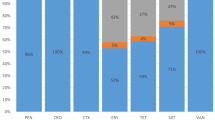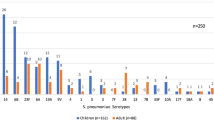Abstract
Multidrug-resistance among Streptococcus pneumoniae isolates, especially of serotype 19A, has increased in several countries recently. Even before the introduction of the pneumococcal conjugate vaccine into the Finnish National Vaccination Programme, the proportion of multidrug-resistant (MDR) pneumococci had doubled from 2007 to 2008, when it reached 3.6% in Southern Finland. Our aim was to look for a possible association between antimicrobial susceptibility and clonality among the MDR isolates. Twelve non-invasive isolates non-susceptible to penicillin, erythromycin, clindamycin, trimethoprim/sulfamethoxazole, and doxycycline from 2008 were available for serotyping, genotyping by multilocus sequence typing (MLST), and detection of genes encoding macrolide resistance and adherence-promoting pili. Two isolates were also resistant to ceftriaxone. Five serotypes, 19F, 19A, 6B, 23F, and 14, and six genotypes from three genetic lineages were found, among which CC320 was the largest. All isolates in this study carried the erm(B) macrolide resistance gene, and the CC320 isolates additionally carried the mef(A/E) macrolide resistance gene. Eleven isolates carried pilus islet 1, while the CC320 isolates also carried the pilus islet 2 genes. The findings emphasize the importance of the careful monitoring of antimicrobial susceptibility and serotype distribution among pneumococci, especially now that antimicrobials and pneumococcal vaccines are in widespread use.
Similar content being viewed by others
References
Jones RN, Jacobs MR, Sader HS (2010) Evolving trends in Streptococcus pneumoniae resistance: implications for therapy of community-acquired bacterial pneumonia. Int J Antimicrob Agents 36(3):197–204. doi:10.1016/j.ijantimicag.2010.04.013
Pilishvili T, Lexau C, Farley MM, Hadler J, Harrison LH, Bennett NM, Reingold A, Thomas A, Schaffner W, Craig AS, Smith PJ, Beall BW, Whitney CG, Moore MR; Active Bacterial Core Surveillance/Emerging Infections Program Network (2010) Sustained reductions in invasive pneumococcal disease in the era of conjugate vaccine. J Infect Dis 201(1):32–41. doi:10.1086/648593
Grijalva CG, Poehling KA, Nuorti JP, Zhu Y, Martin SW, Edwards KM, Griffin MR (2006) National impact of universal childhood immunization with pneumococcal conjugate vaccine on outpatient medical care visits in the United States. Pediatrics 118(3):865–873. doi:10.1542/peds.2006-0492
Pelton SI, Huot H, Finkelstein JA, Bishop CJ, Hsu KK, Kellenberg J, Huang SS, Goldstein R, Hanage WP (2007) Emergence of 19A as virulent and multidrug resistant Pneumococcus in Massachusetts following universal immunization of infants with pneumococcal conjugate vaccine. Pediatr Infect Dis J 26(6):468–472. doi:10.1097/INF.0b013e31803df9ca
Pichichero ME, Casey JR (2007) Emergence of a multiresistant serotype 19A pneumococcal strain not included in the 7-valent conjugate vaccine as an otopathogen in children. JAMA 298(15):1772–1778. doi:10.1001/jama.298.15.1772
Clinical and Laboratory Standards Institute (CLSI) (2009) Performance standards for antimicrobial susceptibility testing; 19th informational supplement. CLSI, Wayne, PA, USA
Siira L, Rantala M, Jalava J, Hakanen AJ, Huovinen P, Kaijalainen T, Lyytikäinen O, Virolainen A (2009) Temporal trends of antimicrobial resistance and clonality of invasive Streptococcus pneumoniae isolates in Finland, 2002 to 2006. Antimicrob Agents Chemother 53(5):2066–2073. doi:10.1128/AAC.01464-08
Kilpi T, Herva E, Kaijalainen T, Syrjänen R, Takala AK (2001) Bacteriology of acute otitis media in a cohort of Finnish children followed for the first two years of life. Pediatr Infect Dis J 20(7):654–662
Bagnoli F, Moschioni M, Donati C, Dimitrovska V, Ferlenghi I, Facciotti C, Muzzi A, Giusti F, Emolo C, Sinisi A, Hilleringmann M, Pansegrau W, Censini S, Rappuoli R, Covacci A, Masignani V, Barocchi MA (2008) A second pilus type in Streptococcus pneumoniae is prevalent in emerging serotypes and mediates adhesion to host cells. J Bacteriol 190(15):5480–5492. doi:10.1128/JB.00384-08
Vainio A, Kaijalainen T, Hakanen AJ, Virolainen A (2011) Prevalence of pilus-encoding islets and clonality of pneumococcal isolates from children with acute otitis media. Eur J Clin Microbiol Infect Dis 30(4):515–519. doi:10.1007/s10096-010-1112-y
Jenkins SG, Brown SD, Farrell DJ (2008) Trends in antibacterial resistance among Streptococcus pneumoniae isolated in the USA: update from PROTEKT US Years 1–4. Ann Clin Microbiol Antimicrob 7:1. doi:10.1186/1476-0711-7-1
Vergison A, Dagan R, Arguedas A, Bonhoeffer J, Cohen R, Dhooge I, Hoberman A, Liese J, Marchisio P, Palmu AA, Ray GT, Sanders EAM, Simões EAF, Uhari M, van Eldere J, Pelton SI (2010) Otitis media and its consequences: beyond the earache. Lancet Infect Dis 10(3):195–203. doi:10.1016/S1473-3099(10)70012-8
Faella F, Pagliano P, Fusco U, Attanasio V, Conte M (2006) Combined treatment with ceftriaxone and linezolid of pneumococcal meningitis: a case series including penicillin-resistant strains. Clin Microbiol Infect 12(4):391–394. doi:10.1111/j.1469-0691.2006.01352.x
Xu Q, Pichichero ME, Casey JR, Zeng M (2009) Novel type of Streptococcus pneumoniae causing multidrug-resistant acute otitis media in children. Emerg Infect Dis 15(4):547–551. doi:10.3201/eid1504.071704
McGee L, McDougal L, Zhou J, Spratt BG, Tenover FC, George R, Hakenbeck R, Hryniewicz W, Lefévre JC, Tomasz A, Klugman KP (2001) Nomenclature of major antimicrobial-resistant clones of Streptococcus pneumoniae defined by the Pneumococcal Molecular Epidemiology Network. J Clin Microbiol 39(7):2565–2571. doi:10.1128/jcm.39.7.2565-2571.2001
Xu X, Cai L, Xiao M, Kong F, Oftadeh S, Zhou F, Gilbert GL (2010) Distribution of serotypes, genotypes, and resistance determinants among macrolide-resistant Streptococcus pneumoniae isolates. Antimicrob Agents Chemother 54(3):1152–1159. doi:10.1128/aac.01268-09
Ansaldi F, Canepa P, de Florentiis D, Bandettini R, Durando P, Icardi G (2011) Increasing incidence of Streptococcus pneumoniae serotype 19A and emergence of two vaccine escape recombinant ST695 strains in Liguria, Italy, 7 years after implementation of the 7-valent conjugated vaccine. Clin Vaccine Immunol 18(2):343–345. doi:10.1128/CVI.00383-10
Del Grosso M, Northwood JG, Farrell DJ, Pantosti A (2007) The macrolide resistance genes erm(B) and mef(E) are carried by Tn2010 in dual-gene Streptococcus pneumoniae isolates belonging to clonal complex CC271. Antimicrob Agents Chemother 51(11):4184–4186. doi:10.1128/AAC.00598-07
Moore MR, Gertz RE Jr, Woodbury RL, Barkocy-Gallagher GA, Schaffner W, Lexau C, Gershman K, Reingold A, Farley M, Harrison LH, Hadler JL, Bennett NM, Thomas AR, McGee L, Pilishvili T, Brueggemann AB, Whitney CG, Jorgensen JH, Beall B (2008) Population snapshot of emergent Streptococcus pneumoniae serotype 19A in the United States, 2005. J Infect Dis 197(7):1016–1027. doi:10.1086/528996
Ardanuy C, Rolo D, Fenoll A, Tarrago D, Calatayud L, Liñares J (2009) Emergence of a multidrug-resistant clone (ST320) among invasive serotype 19A pneumococci in Spain. J Antimicrob Chemother 64(3):507–510. doi:10.1093/jac/dkp210
Tarragó D, Aguilar L, García R, Gimenez MJ, Granizo JJ, Fenoll A (2011) Evolution of clonal and susceptibility profiles of serotype 19A Streptococcus pneumoniae among invasive isolates from children in Spain, 1990 to 2008. Antimicrob Agents Chemother 55(5):2297–2302. doi:10.1128/AAC.01494-10
Dagan R, Givon-Lavi N, Leibovitz E, Greenberg D, Porat N (2009) Introduction and proliferation of multidrug-resistant Streptococcus pneumoniae serotype 19A clones that cause acute otitis media in an unvaccinated population. J Infect Dis 199(6):776–785. doi:10.1086/597044
Choi EH, Kim SH, Eun BW, Kim SJ, Kim NH, Lee J, Lee HJ (2008) Streptococcus pneumoniae serotype 19A in children, South Korea. Emerg Infect Dis 14(2):275–281. doi:10.3201/eid1402.070807
Pillai DR, Shahinas D, Buzina A, Pollock RA, Lau R, Khairnar K, Wong A, Farrell DJ, Green K, McGeer A, Low DE (2009) Genome-wide dissection of globally emergent multi-drug resistant serotype 19A Streptococcus pneumoniae. BMC Genomics 10(1):642. doi:10.1186/1471-2164-10-642
Aguiar SI, Serrano I, Pinto FR, Melo-Cristino J, Ramirez M (2008) The presence of the pilus locus is a clonal property among pneumococcal invasive isolates. BMC Microbiol 8:41. doi:10.1186/1471-2180-8-41
Zähner D, Gudlavalleti A, Stephens DS (2010) Increase in pilus islet 2-encoded pili among Streptococcus pneumoniae isolates, Atlanta, Georgia, USA. Emerg Infect Dis 16(6):955–962. doi:10.3201/eid1606.091820
Basset A, Trzcinski K, Hermos C, O’Brien KL, Reid R, Santosham M, McAdam AJ, Lipsitch M, Malley R (2007) Association of the pneumococcal pilus with certain capsular serotypes but not with increased virulence. J Clin Microbiol 45(6):1684–1689. doi:10.1128/JCM.00265-07
Acknowledgments
We acknowledge the use of the pneumococcal MLST database located at Imperial College, London, and funded by the Wellcome Trust.
Conflict of interest
The authors declare that they have no conflict of interest.
Author information
Authors and Affiliations
Corresponding author
Rights and permissions
About this article
Cite this article
Siira, L., Jalava, J., Tissari, P. et al. Clonality behind the increase of multidrug-resistance among non-invasive pneumococci in Southern Finland. Eur J Clin Microbiol Infect Dis 31, 867–871 (2012). https://doi.org/10.1007/s10096-011-1386-8
Received:
Accepted:
Published:
Issue Date:
DOI: https://doi.org/10.1007/s10096-011-1386-8




